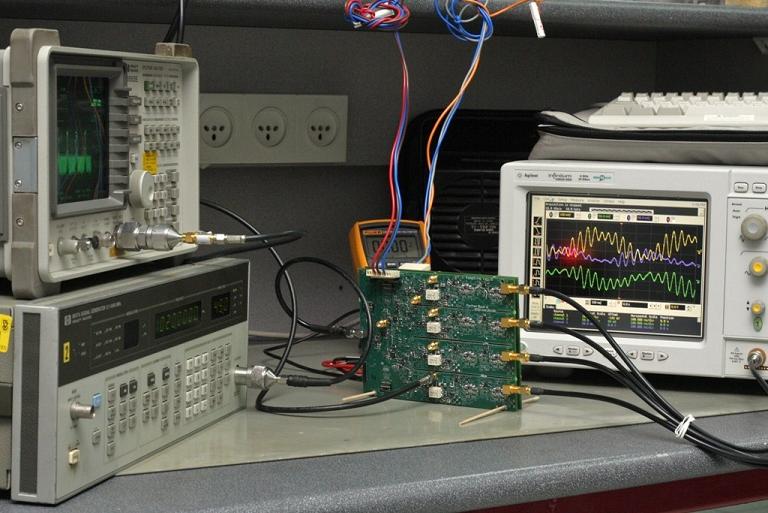The researchers built a prototype of an electronic card that allows broadband signal sampling using an extremely low sampling rate; The development may allow the sampling of high-speed signals, their storage and processing in an efficient way in hundreds of percent of the existing; The Technion registered several patents on the technology; The sample market is estimated at billions of dollars a year

Broadband models that exist in the market today are heavy on hardware or based on complex software to enable the reception of broadband signals and a high rate of storage and processing of digital information. The researchers of the Faculty of Electrical Engineering at the Technion, Professor Yonina Elder and her doctoral student Moshe Meshali, built a prototype of a model that requires only one processor. The invention also saves the need for processors with high calculation capacity. It is estimated that the cost for an industrial manufacturing component will be many tens of percent cheaper compared to the fast models available in the market today.
While working on complicated mathematical formulas, the two Technion researchers managed to "break" the basic barrier formulated at the beginning of the last century in Nyquist and Shannon's sampling theorem. According to this theorem, if a signal is sampled at twice the maximum frequency in the signal, then the signal can be accurately reproduced by appropriate processing. This sentence is the pillar of digital communication, and is the basis of most
The digital devices today. Since the ambition today is to use these devices in as wide a bandwidth as possible, it is necessary to increase the signal sampling rate. Technological limitations currently limit the maximum speed at which it is possible to sample, and as a result, a large storage volume, power and, of course, high cost are required.
The said invention has many potential applications, such as improving radar performance and increasing the capacity of audio records. Another potential market is the medical market, where the sampling speed translates into the patient's exposure time to the device emitting dangerous radiation. From an economic point of view, there is a big advantage here, since more patients will be able to be tested.
"In digital devices, a physical signal is represented by a series of 'bits'. For example, music or a picture is stored on a computer using a series of numbers," explains Professor Alder. "The ear cannot hear numbers, of course," she adds. "This is where the sampling and recovery process comes in. The goal in the sampling phase is to intelligently convert a physical signal into bits, that is, into a series of 'zeros' and 'ones'. The digital 'tape' samples the signal being played and translates it into bits. The key at this stage is to perform the conversion in a way that allows you to later recreate the real signal. This work is carried out in the reconstruction phase, when the bits are translated into a physical signal that can be heard or seen."
"Who among us is not used to saying - I watched a movie in HDTV quality or listened to music from the digital player", adds Moshe Mashali. "We forget that the human system is only capable of sensing, seeing and hearing physical signals. No one is able to see or hear series of numbers. In the interface between the digital world and the analog world there is a component that models the physical signal into a series of numbers, and at the end it is carried out to return to the physical world that the human system can absorb."
Nyquist and Shannon's basic theorem, which has been studied for years as the cornerstone of sampling theory, contains a strict assumption about the content of signals. Moshe Mashali's goal, under the guidance of Professor Alder, was to design a single sampling system for signals with many wide transmission bands, so that the system could sample and reproduce these signals at a significantly lower rate than currently available. The breakthrough was achieved by exploiting the fact that parts of the spectrum have no transmission. "The idea is to use the 'holes' in the spectrum wisely, to significantly lower the sampling rate without damaging the signal," explains Professor Elder. "The difficulty is that since we don't know where in the spectrum those holes are, traditional mathematical models can no longer help in the characterization of these signals and their processing. What we were able to prove is that the very fact that we know that the signal does not occupy the full spectrum allows us to reduce the sampling rate, which was not possible until now."
This discovery was preceded by a lot of long-term mathematical work, and it arouses great interest in the scientific world from being published in the scientific press.
In the picture: a test system for the sample card developed at the Technion. Photo - Technion Spokesperson.

3 תגובות
By the way, those looking for information about the innovation can find it on Moshe Meshali's website:
http://www.technion.ac.il/~moshiko/software.html
In short, unlike previous works that made assumptions about the frequencies that exist in the signal,
When the holes in the frequency domain are known, this work does not assume knowledge of the ranges of the holes
But only that the signal is created from several transmission factors, each of which is assigned a range.
Well done!!! The main significance of the work is not only in the construction of the card, whose benefit is enormous, but
In proving the mathematical background. The Nyquist theorem is truly a cornerstone of the entire field. Breaking it and going in a different direction is a bigger breakthrough. Congratulations to the researchers for their courage.
I am an engineer by profession who also knows Nyquist's theorem and I (like many other engineers) had the feeling that it required 'too much' but from the feeling and intuition to the actual breakthrough, the road is long.
Again, kudos to the researchers.
And how will it affect the studio sound card market?